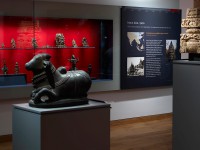Room 32 | India 600-1900 gallery
Explore Hindu, Buddhist and Jain art from India, the Himalayas and Southeast Asia.

Separate from the north in languages and ethnicity, the sub-tropical regions of South India adjoin the central Deccan plateau, where north and south have always met. Hinduism, Buddhism and Jainism all flourished from early times in South India. But from around AD 800, strong Hindu devotional cults, centred on Shiva and Vishnu, became dominant.
A vigorous tradition of temple building flourished in Tamilnadu, especially under the powerful Chola dynasty (AD 850-1250) which erected a series of huge temple complexes, profusely decorated with stone sculptures and relief carvings.
Bronze sculpture also reached a peak of perfection under the Cholas, revealing an exceptional grace of pose and gesture deriving from temple dance traditions. The larger bronze images were made to be portable and were carried out from the temple in procession during annual religious festivals.
Central India and the Deccan: Folk bronzes
 Figure of Shiva as Virabhadra (EA1964.157)
Figure of Shiva as Virabhadra (EA1964.157)
 Shivalinga shrine (EA2003.63)
Shivalinga shrine (EA2003.63)
 Incense holder in the form of Garuda (EAX.281)
Incense holder in the form of Garuda (EAX.281)
 Incense holder in the form of a woman (EAX.279)
Incense holder in the form of a woman (EAX.279)
 Temple lamp (EAX.284)
Temple lamp (EAX.284)
 Figure of Durga slaying the Buffalo-demon (EAX.280)
Figure of Durga slaying the Buffalo-demon (EAX.280)
 Figure of Shiva and Parvati (EAX.2290)
Figure of Shiva and Parvati (EAX.2290)
 Figure of Shiva and Parvati (EAX.283)
Figure of Shiva and Parvati (EAX.283)
 Figure of a deity or warrior-hero on a horse (EA1964.160)
Figure of a deity or warrior-hero on a horse (EA1964.160)
 Temple lamp with base in the form of a turtle (EA1995.92)
Temple lamp with base in the form of a turtle (EA1995.92)
Bronzes from the Deccan
 Figure of Durga slaying the Buffalo-demon (EA1980.62)
Figure of Durga slaying the Buffalo-demon (EA1980.62)
 Figure of Shiva as Nataraja, Lord of the Dance (EA2013.102)
Figure of Shiva as Nataraja, Lord of the Dance (EA2013.102)
 Shrine with figure of Vishnu (EA2005.12)
Shrine with figure of Vishnu (EA2005.12)
 Figure of Shiva and Parvati (Uma-Maheshvara) (EA2013.96)
Figure of Shiva and Parvati (Uma-Maheshvara) (EA2013.96)
 Figure of Krishna, the Butter Thief (EA2013.101)
Figure of Krishna, the Butter Thief (EA2013.101)
 Dancing figure of Ganesha with attendants (EA2013.82)
Dancing figure of Ganesha with attendants (EA2013.82)
 Figure of the Tirthankara Parshvanatha (EA2013.83)
Figure of the Tirthankara Parshvanatha (EA2013.83)
 Figure of a Tirthankara, or Jain saviour (EA2013.84)
Figure of a Tirthankara, or Jain saviour (EA2013.84)
 Figure of Nandi, the bull of Shiva (EA2013.100)
Figure of Nandi, the bull of Shiva (EA2013.100)
South Indian bronzes
 Figure of Krishna Venugopala, the Flute-playing Cowherd (EA2013.99)
Figure of Krishna Venugopala, the Flute-playing Cowherd (EA2013.99)
 Figure of the saint Manikkavachakar (EA2013.54)
Figure of the saint Manikkavachakar (EA2013.54)
 Figure of an elephant and rider from a hanging lamp (EA2013.97)
Figure of an elephant and rider from a hanging lamp (EA2013.97)
 Figure of Ganesha (EA2013.85)
Figure of Ganesha (EA2013.85)
 Standing figure of the Buddha (EA2013.42)
Standing figure of the Buddha (EA2013.42)
 Standing figure of Shiva (EA2013.103)
Standing figure of Shiva (EA2013.103)
 Pier from a model of the Pudu-Mandapa (EA1956.673)
Pier from a model of the Pudu-Mandapa (EA1956.673)
 Pier from a model of the Pudu-Mandapa (EA1956.674)
Pier from a model of the Pudu-Mandapa (EA1956.674)
 Model of a Shiva temple (EA2005.10)
Model of a Shiva temple (EA2005.10)
 Toy elephant (EA2013.81)
Toy elephant (EA2013.81)
 Figure of Kubera, god of wealth (EA2013.55)
Figure of Kubera, god of wealth (EA2013.55)
 Brass guldan, or flask (EA1994.44)
Brass guldan, or flask (EA1994.44)
 Figure of Krishna Vatapatrashayi (EA1958.175)
Figure of Krishna Vatapatrashayi (EA1958.175)
 Figure of the sage Patanjali (EA2005.11)
Figure of the sage Patanjali (EA2005.11)
 Bronze flask (EA1994.42)
Bronze flask (EA1994.42)
Freestanding sculpture
Notice
Objects may have since been removed or replaced from a gallery. Click into an individual object record to confirm whether or not an object is currently on display. Our object location data is usually updated on a monthly basis, so contact the Jameel Study Centre if you are planning to visit the museum to see a particular Eastern Art object.
© 2013 University of Oxford - Ashmolean Museum










